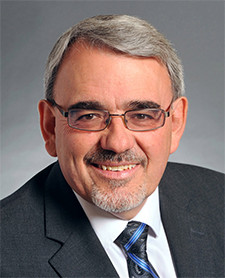As the sport of “wake surfing” has caught on in Minnesota, it has led to fierce local battles over whether the activity should be restricted — or even banned in places — because of damage it can cause to shorelines, property and fish habitat.
Now, debates that began at lake associations and city halls have spilled over into the Legislature, where resort owners, environmentalists, boat dealers and lake-front residents are split over how to regulate a growing sport and its signature powerful wakes.
An environmental committee in the Republican-led Senate approved a bill on Wednesday aimed at keeping wake surfing — in which boats create waves big enough for people to surf without the need of a tow rope — 200 feet from shore, docks, swimmers and other boats. Supporters say the measure, sponsored by Sen. Bill Weber, R-Luverne, is backed by industry research and boat dealers, and would address problems while keeping lakes open to surfers.

State Sen. Bill Weber
Jeremy Wiczek, an owner of the boat dealership Nisswa Marine, told the Senate panel that he tries to advise buyers on best practices for avoiding harm and bothering other lake-goers. But he endorsed a 200-foot restriction as a practical, and perhaps necessary, step.
“While there are disrespectful and uneducated boaters in all categories, the boaters in the wake surf community stand out further because of impact these waves can have on other boaters and properties,” Wiczek said. “We do our best to educate all boaters. However we recognize that this may not be enough.”
But a contingent of homeowners and environmental advocates have pushed for tougher regulations — or at least more research on wake boats. They view a 200-foot buffer as an ineffective solution that wouldn’t prevent disruption and damage.
Concerns about shorelines, lake beds
Boats used for wake surfing move relatively slowly, typically between 10 and 12 miles per hour, said Adam Fletcher, a salesman for Minnesota Inboard Water Sports. The boats are designed to make large enough wakes that a person doesn’t need a tow rope to ride them, unlike water skiing or wakeboarding.
Fletcher, whose dealership sells four of 10 ski boats powered by inboard motors in Minnesota, said inboard boats are the only growing segment of the boating industry. And what people want to use them for is wake surfing. “Surfing is a huge percent of what most families are actually doing behind their boats these days,” he said.
Yet as boats equipped for surfing have spread, so have complaints about the large, powerful wakes they kick up. Chuck Becker, an anti-surfing activist who lives on Big Sugar Bush Lake north of Detroit Lakes, said boats have chased kayakers and canoers out of the water, sent waves over pontoons and damaged docks.
Donna Burt, who helped found the organization Safe Wakes for Small Lakes, lives on Lotus Lake near Chanhassen. She said wake surfing sends strong waves crashing against the shore of her narrow lake, eroding her shoreline, putting infrastructure at risk and damaging aquatic plants like cattails. Burt said her husband fell off a dock and bruised his ribs last year when a “large artificial wake” hit the shore. “Moments before this, he said ‘Donna watch out, here it comes,’” Burt said. “I turned my head and he was in the water. That’s how powerful they are.”
Becker and others raised concerns about the effect of wakes below the water’s surface. Wake-creation systems from the powerful boats can scour the bottom of lakes, disturb fish habitat, uproot plants and disturb sediment that can release phosphorous and nutrients that cause algal blooms, many contend. And water tanks on the boats may also spread invasive species.
Local debates lead to state battles
Controversy over wake surfing is not unique to Minnesota. Oregon has been pondering new regulations for boaters on the Willamette River, where federal officials say the sport can harm salmon and steelhead trout.
And while Minnesota law generally prohibits boating that harasses others or causes property damage, there are no state regulations specific to wake surfing. People can, however, enact local ordinances to govern what happens on their lakes — as long as they are approved by the state Department of Natural Resources. Some efforts to make local wake boat rules have been hotly contested.
Becker said he hired a hydrology consultant to help research wake boats and their effects, but despite backing from his Lake Association, a push for a local ban has not been universally supported. Other property owners, and the Waters Sports Industry Association, an influential trade group, retained a lawyer that threatened litigation against ordinances.
In a letter to the Big Sugar Bush Lake Association, attorney Tami Norgard wrote the lake was classified by the DNR to allow moderate recreation and development. “A wake boat ban would be a poor decision legally, economically and as a matter of public policy for a township within Becker County,” she wrote. Becker is still working to get an ordinance before his local township.
Burt and JoAnn Syverson, who also helps run Safe Wakes, have tried and failed to push an ordinance restricting wake surfing on Lotus Lake at the Chanhassen City Council.
Yet as complaints have risen with the state DNR, the boating industry has promoted courteous surfing by recommending a 200-foot buffer from shore and others, avoiding loud music and more.
Now they’re pushing the 200-foot regulations at the Legislature. Those restrictions are based on research commissioned by the WSIA and led by Clifford Goudey, who told the Senate panel last week that energy from surfing waves “start out very high but dissipate rapidly compared to other wakes.”
“In all the cases that we tested, there is significant wave energy in the first 200 feet of travel,” Goudey said. “After that it tends to be less and less. So the most important reductions in wave energy can occur in the first 200 feet.”
Those findings have been met with skepticism by opponents and many DFLers. Becker highlighted 2014 research from the University of Quebec in Montreal that says wake energy has “considerable” impact on shorelines from boats passing within 300 feet, but no significant effect on shorelines when boats are nearly 1,000 feet away. A 2015 study from Laval University in Quebec City says wake surfing impacts lake beds and plants — promoting the development of algae — when boats operate in water less than 16 feet deep.
Still, the Republican-led Environment and Natural Resources Policy and Legacy Finance Committee approved the bill on a party-line 7-to-5 vote, and the measure will now head to the Senate floor for consideration. (The measure is not solely supported by the GOP, it does have DFL sponsors in the House and Senate.)
Weber, the Luverne Republican sponsoring the Senate version of the bill, said the measure sets a minimum restriction for wake surfing boats where one doesn’t exist today. The issue can be revisited in light of new science, Weber said, and it doesn’t stop local governments from setting tougher ordinances. “I think that for bodies of water that are uniquely sensitive to boat wakes, certainly concerned citizens can petition DNR for tighter restrictions as well as other local regulators,” he said.

State Rep. John Persell
Even if the Senate approves Weber’s bill, it’s unlikely to gain traction in the DFL-controlled House. State Rep. John Persell, a Bemidji Democrat who chairs the House Environment and Natural Resources Policy Committee, said he couldn’t take the industry study and the 200-foot recommendation “at face value” unless it’s published in a peer-reviewed journal.
At first, Persell had considered a bill that would keep wake boats 1,000 feet from shore. But Republicans and boat dealers have protested a 1,000 foot rule because they say it would effectively close off many lakes to the sport.
Ultimately, Persell dropped the idea. He said he didn’t want to try to pass a middle-ground, compromise bill that isn’t based on research. He also wants to consider restrictions on what depth the wake boats can operate in. A draft of Persell’s new measure, expected to be introduced this week, would order the DNR to develop recommendations for a “watercraft operator’s safety program” for some boats larger than 16 feet that teaches people how to reduce conflicts with other water users, prevent the spread of invasive species and reduce ecological impacts.
The DNR program would specifically require people driving boats with “enhanced wake technology” to complete an additional course based on new research by the Minnesota Aquatic Invasive Species Research Center, as well study of “enhanced” wakes and their impact on lake sediments and plants done by the St. Anthony Falls Laboratory.
By January 2021 the DNR would present its recommendations to the Legislature for lawmakers to consider if the program should be approved. “What I want to do is get more information about the potential impacts as we come to understand those,” Persell said.





Recent Comments